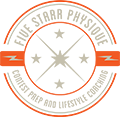When you go through the certification process to be a personal trainer, you learn about various ways of assessing the body to determine progress. We’re taught to take measurements with a tape (waist, hips, etc), get a scale reading, and how to determine someone’s body fat percentage (typically using skin fold calipers). With a weight and a body fat percentage, we can then determine your lean body mass (muscle, bone, organs, fluids) and your fat mass (adipose tissue). This, in theory, will help people arrive at a reasonable number for a goal weight and help establish a reasonable time frame within which to achieve that.
That’s fine. I still tell people that I am a personal trainer first – concerned with your overall metabolic and biomechanical health and well being primarily – and a bodybuilding coach second – concerned with your look and performance on-stage as a secondary focus. However – in this area, I let the bodybuilding coach win – measuring your body fat percentage is not the way to proceed if competing is your goal. Let’s talk about why.
First, the obvious: no one is going to come up next to you on stage with calipers and measure your skin folds during your competition. It doesn’t matter what your body fat percentage is. What does matter is how lean you look – and for that, we will use our eyeballs. You know, the things that the judges use to determine who wins.
But that’s my opinion, and I realize that – I feel my eyes are more useful. How about some more empirical evidence as to why we should stay away from body fat percentage as an assessment tool when it comes to contest prep.
First, let’s talk about how skin fold measurements are used to arrive at an estimate for your body fat percentage (key word right there in italics). Skin folds at various sites are measured (more on that part later), the totals are added up and plugged into a formula that estimates your body density. Your body density estimate is then plugged into another formula that estimates your body fat percentage. Even when done correctly, this is something that provides accuracy that is +/- 3%. So if you calculate that your body fat is 15% and you weigh 200 pounds, that means you are carrying between 24 and 36 pounds of fat on your body. Sorry, I’d like to make decisions and judgment calls based on something with a little more precision if we were to go down this road.
And again – this is under ideal circumstances. In reality, your margin of error is going to vary WILDLY based upon that most unknown of factors: the skill of the person taking the measurements. It is not something that any yokel can do. It takes a lot of skill and practice to get accurate readings consistently. How should I, as your online coach, interpret numbers that are reported to me from someone who measured your body fat at your local gym? With a giant, massive grain of salt.
Ultimately, bodybuilding is a subjective sports that is based on what judges see. Using a good set of eyes to gauge your progress is absolutely the way to go. I find that the individuals who are typically curious as to their body fat percentage are looking for some kind of validation – assurance that they are as lean as they need to be, or they are caring more fat than they need to be and should be working “harder” in some way. While a simple number like that is objective, it loses it’s usefulness if it’s inaccurate at the same time, which a body fat estimate inherently is. Go with the visual route, and find someone who’s eyes you can trust to fairly judge your progress!
